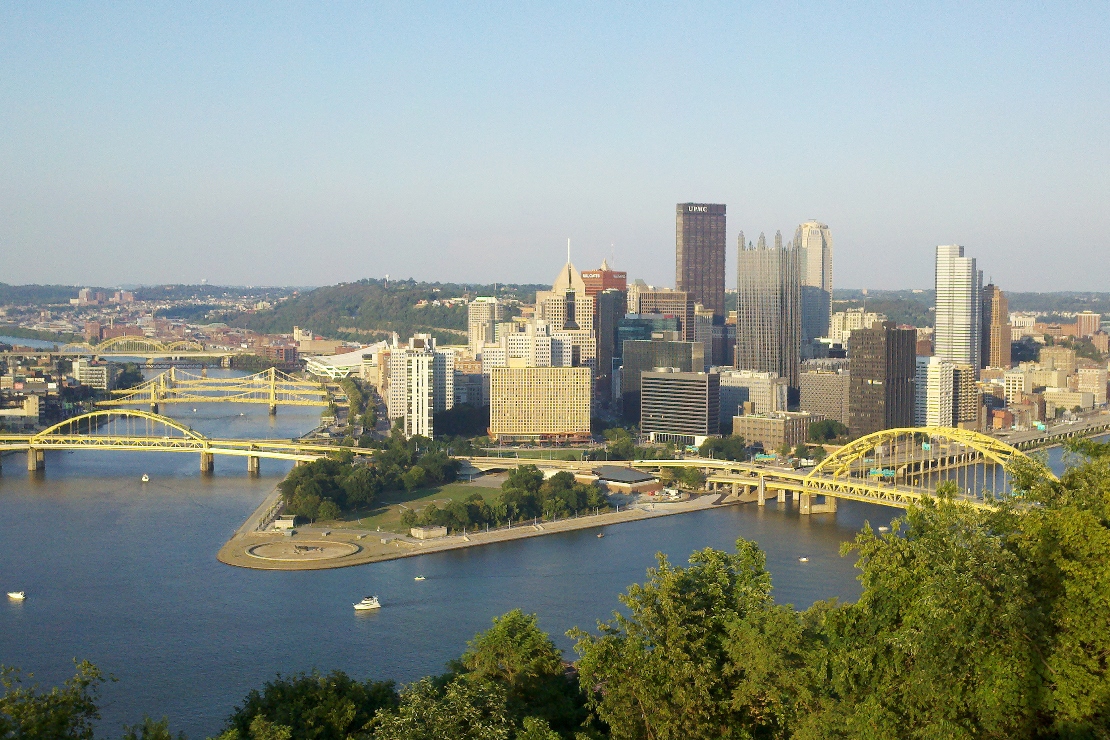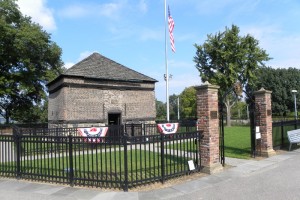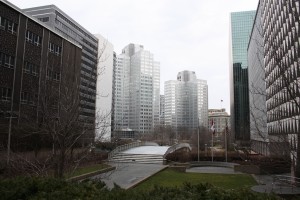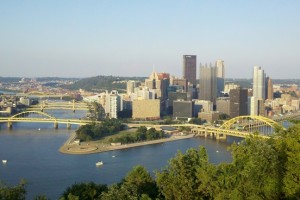A Place In Time is a regular feature in Pennsylvania Heritage Magazine, published quarterly by the Pennsylvania Historical and Museum Commission, and available for purchase at ShopPaHeritage.com. A subscription to the magazine is a benefit of membership in the Pennsylvania Heritage Foundation, the nonprofit partner of the PHMC.
Throughout much of its industrial history, Pittsburgh had an image problem. In 1868 James Parton wrote in The Atlantic Monthly that it was “Hell with the lid taken off.” Later, it became known as “The Smoky City.” Pollution was a big issue, but there were other problems, such as traffic congestion, flooding and blight that made Pittsburgh a less-than-desirable place to live. It was so bad that in 1944 The Wall Street Journal characterized Pittsburgh among cities “that had bleak futures.” One could argue that nowhere were these issues more visible than at the Point, the area of downtown where the Allegheny River and the Monongahela River join to form the Ohio River. Prior to World War II, the Point was a smoky, gritty, blighted area that was home to two railyards, several exposition halls, offices, clubs and hotels. It was also home to the Fort Pitt Blockhouse, a 1764 building owned by the Daughters of the American Revolution and the sole remaining aboveground structure from the Colonial-era Fort Pitt.
In all fairness, Pittsburgh did not ignore these issues prior to the mid-20th century. In the early part of the century, the city considered several recommendations for the future of the Point. One of the more interesting proposals, advanced in 1947 by Frank Lloyd Wright, was to transform the Point into an automobile-centered amusement park. The formulation of plans, however, could not overcome two major impediments, the Manchester and Point Bridges near the Point’s tip, which would need to be moved in order to redevelop the area.
Several political developments in the 1940s allowed redevelopment at the Point to move beyond plans and recommendations, however. In 1945 Pennsylvania’s Urban Redevelopment Law allowed cities to acquire privately owned property, clear it and sell it to private companies for redevelopment. In 1947 amendments to the state’s Insurance Act allowed insurance companies to invest in real estate.
With the 1945 announcement by Governor Edward Martin that the state would fund “clearing of thirty-six acres at the lower Point, removal of two unsightly bridges, construction of two new bridges upstream, and creation of a state park at the Point,” the redevelopment of 59 acres at the Point began. The plan called for 36 acres to become Point State Park and 23 acres to be turned over to the Equitable Life Assurance Company to develop. Between 1945 and 1974 the Point was completely redeveloped . A park and fountain were created and 12 mostly high-rise buildings were constructed from 1950 to 1969 in two landscaped plazas– Equitable Plaza, atop an underground parking garage, and Gateway Plaza. One building, the former Pittsburgh Press Building, dates to 1927, but was refaced in 1964.
The redevelopment of these 59 acres at the Point was only one part of the postwar planning effort to reimagine Pittsburgh. The concomitant efforts toward pollution control through city ordinances, projects to decrease flooding and transportation improvements to remove through traffic from the Point contributed to the success of the redevelopment and helped create a new postwar city.
The Pittsburgh Renaissance Historic District was listed in the National Register of Historic Places on May 2, 2013, as part of a PHMC Keystone Historic Preservation Grant funded project to reexamine three previously-listed historic districts in downtown Pittsburgh—Firstside Historic District, Fourth Avenue Historic District, and Pittsburgh Central Downtown Historic District—and amend the nominations and to prepare a new nomination for the Pittsburgh Renaissance Historic District. The grant applicant, Pittsburgh History and Landmarks Foundation, undertook the project to assist in the revitalization of downtown Pittsburgh.




Very nice article, I enjoyed reading your post, very nice share, I want to twit this to my followers. Thanks!
Game Lover – https://games.lol
Wow, I love your post today! This in just the perfect time. Thanks a bunch!
This place is so nice, thank you for sharing this, hope to be here soon. http://www.dogwalkersvancouver.co/
Wow! I love the place , peaceful and clean. I want to visit here!
The place is so clean! I love it so much!
Wow. I love that place.
Pittsburgh is such a beautiful place.
https://www.landscapingservicescolumbia.com
It was as beautiful as the last time I’ve been here!
Following World War II, Pittsburgh launched a clean air and civic revitalization project known as the Renaissance. Don’t you think we must do the same today?
I love this place, I always visit here in my daughter’s town.
Awesome photos. I love to live here.
Pittsburgh plays an essential role in the history of our country. Most people are familiar with Pittsburgh’s background as an industrial center for coal mining and steel production.